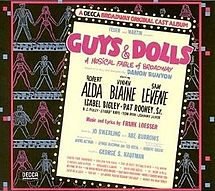
From Broadway To 52nd Street
The music composed for Guys & Dolls by Frank Loesser was first heard on the stage at the 46th Street Theatre on January 24, 1950. It became a part of the blockbuster club with a total of 1200 performances. The show starred Robert Alda, Sam Levene and Vivian Blaine, the latter who would go on to star in the 1955 movie version with Frank Sinatra, Marlon Brando, Jean Simmons and Stubby Kaye. Coming out of the play into jazz prominence were the songs If I Were A Bell, I’ll Know, I’ve Never Been In Love Before and Luck Be A Lady Tonight.
The Story: New York gambler, Nathan Detroit, tries to set up a floating crap game since the highest of the high rollers, Sky Masterson, is in town. All the while the police are putting on the heat to prevent the game from happening. Nathan bets Sky that he cannot woo any girl he chooses. He picks Salvation Army’s Sister Sarah and off to Cuba she and Sky go. Ultimately the game takes place in the empty Salvation Army headquarters. Nathan has promised his girl Adelaide that he has quit gambling and will marry her. Romance ensues for all and both Nathan and Sky marry in the end.
Although Guys and Dolls was selected as the winner of the 1951 Pulitzer Prize for Drama, the prize was not awarded because writer Abe Burrows was being investigated by the House Un-American Activities Committee. Do to these troubles with HUAC, the Trustees of Columbia University vetoed the selection, and no Pulitzer for Drama was awarded that year.
Jazz History: In 1950, Charlie Parker, despite a severe drug problem, was at the height of his career. It was during that same year that he became the first jazz musician to record with a string ensemble, which produced the album Charlie Parker With Strings. The year also saw the beginning point were a series of singles on Capitol Records of a nonet led by trumpeter Miles Davis, collected and released first on a ten-inch and later a twelve-inch as the Birth of the Cool. Cool jazz recordings by Chet Baker, Dave Brubeck, Bill Evans, Gil Evans, Stan Getz and the Modern Jazz Quartet usually have a “lighter” sound that avoided the aggressive tempos and harmonic abstraction of bebop. Cool jazz later became strongly identified with the West Coast jazz scene, but also had a particular resonance in Europe, especially Scandinavia, with emergence of such major figures as baritone saxophonist Lars Gullin and pianist Bengt Hallberg. However, blind Chicago pianist Lennie Tristano set out the theoretical underpinnings of cool jazz. Its influence stretches into such later developments as bossa nova, modal jazz, and even free jazz.
Sponsored By
www.whatissuitetabu.com
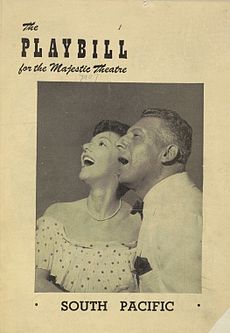
From Broadway To 52nd Street
South Pacific hit the stage of the Majestic Theatre on April 7, 1949 in the first of a 1,925 performance run. Richard Rodgers and Oscar Hammerstein composed the music from the compositions “Happy Talk”, “Some Enchanted Evening” and “A Wonderful Guy” became jazz standards. The musical starred Enzio Pinza, Mary Martin, Juanita Hall, William Tabbert, Betta St. John and Myron Mccormick.
The Story: An American nurse stationed on a South Pacific island during World War II falls in love with a middle-aged French expatriate plantation owner but struggles to accept his mixed-race children. A secondary romance, between a U.S. lieutenant and a young Tonkinese woman, explores his fears of the social consequences should he marry his Asian sweetheart. The issue of racial prejudice is candidly explored throughout the musical, most controversially in the lieutenant’s song, “You’ve Got To Be Carefully Taught”. Supporting characters, including a comic petty officer and the Tonkinese girl’s mother, help to tie the stories together. However, Hammerstein’s lack of military knowledge hampered his writing that part of the script, so the director of the original production, Logan, assisted him, receiving credit as co-writer of the book.
Broadway History: The production won an unprecedented 10 Tony Awards including Best Musical, Best Score and Best Libretto. It is the only musical production to win Tony Awards in all four acting categories. Its original cast album was the bestselling record of the 1940s. Due to it’s 1,925 it was ushered into the blockbuster hall of fame surpassing it’s predecessors by more than 800 performance.
Sponsored By
www.whatissuitetabu.com
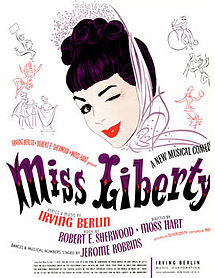
From Broadway To 52nd Street
Miss Liberty brought to the stage its star Eddie Albert at the Imperial Theatre on July 15, 1949. The show ran for three hundred and eight performances with music composed by Irving Berlin. The song “You Can Have Him” became a jazz standard.
The Story: In 1885, New York Herald publisher James Gordon Bennett assigns novice reporter Horace Miller to find the woman who served as Frédéric Auguste Bartholdi’s model for the Statue of Liberty. In the artist’s Paris studio, Miller sees a photograph of Monique DuPont and mistakenly believes she was the one. Bennett arranges for her and her grandmother to accompany Horace back to New York City, where she becomes a media darling. When rival publisher Joseph Pulitzer discovers it was Bartholdi’s mother who actually posed for him, he exposes Monique as a fraud in his New York World. She faces deportation until a sympathetic Pulitzer comes to her rescue, paving the way for her to plan a future with Horace, who jilts his American girlfriend Maisie Doll in favor of the French beauty.
Jazz History: As the widely performed bebop or hot jazz began to wane in some sectors of the country, cool jazz began to emerge by the early 1950s. “Cool” was used to describe a kind of toned-down jazz. Later the term became associated with a number of white musicians who relocated to California where they could get day gigs at movie studios, unlike black musicians, while playing jazz at night. In this form it was called West Coast jazz. For white players to represent a kind of cool jazz is ironic since the idea of coolness has its roots in Black culture. Cool jazz contrasts with hot jazz in that it has limited vibrato, restrained timbre, stable dynamics, melodic calm, sophisticated harmonies that tempered the blues idiom.
Sponsored By
www.whatissuitetabu.com
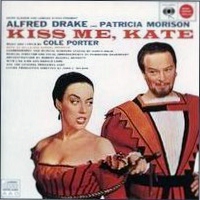
From Broadway To 52nd Street
Kiss Me Kate opened its doors at the New Century Theatre on December 30, 1948 and was the second musical to be lauded as a blockbuster with a run of 1077 performances. Alfred Drake, Patricia Morrison, Lisa Kirk and Harold Lang were the stars of the show, who sung the music composed by Cole Porter, So In Love and From This Moment On, which became jazz standards. The musical won the very first Tony Award for Best Musical presented in 1949.
The Story: While cast members of a revival of Shakespeare’s Taming of the Shrew celebrate another opening, another show, the show’s stars, Fred & Lilli, celebrate their first anniversary of their divorce. They reminisce about better times. Fred sends Lilli a bouquet, leading her to believe he is still in love with her. Misunderstanding leads to argument between the two. Meanwhile, one of the cast members signs Fred’s name to his gambling debt. Goons arrive to collect and Fred convinces them to make Lilli perform. Debt is voided on a technicality. Fred & Lilli make up over the course of the evening and recognize they do still love each other)
Broadway History: In 1880, a stretch of Broadway between Union Square and Madison Square was illuminated by Brush arc lamps, making it among the first electrically lighted streets in the United States. By the 1890s, the portion of Broadway from 23rd Street to 34th Street was so brightly illuminated by electrical advertising signs, that people began calling it “The Great White Way.” When the theater district moved uptown, the name was transferred to the Times Square area.
Sponsored By
www.whatissuitetabu.com
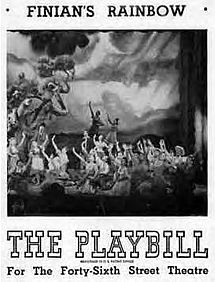
From Broadway To 52nd Street
Finian’s Rainbow opened on January 10, 1947 at the 46th Street Theater starring Albert Sharpe, Ella Logan and David Wayne. Burton Lane and E.Y. Harburg composed the score for this stage production that ran 725 performances. The musical would be made into a movie some twenty-one years later to star Fred Astaire and Petula Clark. From this musical came the encores with the jazz classics Old Devil Moon, Look To The Rainbow and How Are Things In Glocca Morra.
The Story: An Irishman named Finian seeking his fortune steals a pot of leprechaun gold and arrives in America to plant it at Fort Knox and watch it grow. However, the leprechaun who follows him is threatened to become human if it is not returned. When they stop in Rainbow Valley, Finian’s daughter falls in love with a local. During his brief stay, Og the leprechaun, convinces racist Senator Rankin to turn over a new leaf by magically turning him black. The Senator recants and Finian gives back the gold and continues his wanderings.
Jazz History: Jazz was created in 1947 as an artist’s book of some one hundred prints based on paper cutouts by Henri Matisse, who was in his seventies and in poor health when he began this project. No longer able to draw or paint easily with a pencil or brush, he used scissors to cut out simple forms from brightly colored paper painted to his specifications with gouache. He then arranged them on another sheet of gouache-painted paper.
The original intention was for Matisse to illustrate poems written by a French author. As Matisse began, he used a large fluid brush to write notes to himself on construction paper about his thoughts as he created the images. The simple visual appearance of the words pleased Matisse, and he suggested using his roughly painted words in juxtaposition with the images, rather than the original poems. The publisher agreed.
None of the original copies were bound, and many of the purchasers arranged with prominent artists like Cocteau or famous graphic designers to create binders for the pages. Each of the pages is about 24 inches by 12 inches and folded in the center. The original edition of September 30, 1947 consisted of 250 sets of prints and sold for $120 each.
Sponsored By
www.whatissuitetabu.com


